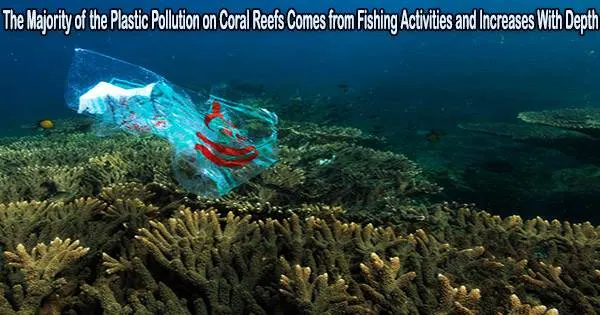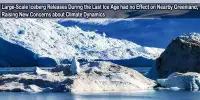Plastic pollution refers to the environmental problem caused by the accumulation of plastic waste in the natural environment, particularly in oceans, rivers, lakes, and land. Plastic pollution has become a significant global issue due to the widespread use of plastic products and improper waste management practices.
In a paper published today in Nature, researchers from the California Academy of Sciences, University of São Paulo, University of Oxford, University of Exeter, and other collaborators reveal the extent of plastic pollution on coral reefs, finding that debris increases with depth, largely stems from fishing activities, and is correlated with proximity to marine protected areas.
The researchers are able to determine what conservation efforts should be prioritized and where to protect our planet’s vulnerable coral reefs through underwater visual surveys that cover more than two dozen locations in the Indian, Pacific, and Atlantic oceans. By exposing the abundance, distribution, and drivers of plastic pollution at various depths, the researchers are able to do this.
“Plastic pollution is one of the most pressing problems plaguing ocean ecosystems, and coral reefs are no exception,” says Hudson Pinheiro, PhD, the study’s lead author, a biologist at the Center for Marine Biology of the University of São Paulo, and an Academy research fellow. “From macroplastics that spread coral diseases to fishing lines that entangle and damage the structural complexity of the reef, decreasing both fish abundance and diversity, pollution negatively impacts the entire coral reef ecosystem.”
Surveying reefs from shallow to never-before-seen
Over 1,200 visual surveys were carried out by the researchers in 84 shallow and mesophotic reef ecosystems spread across 14 countries for the study. Researchers used specialized diving equipment that few other scientific dive teams are trained to properly use in order to examine difficult-to-reach mesophotic or ‘twilight zone’ coral reefs that reside between 100 and 500 feet (30 and 150 meters) deep.
The study found that coral reefs are far less polluted than shoreline ecosystems like beaches and wetlands, but appear to be more polluted by plastics and other human-derived trash than other marine habitats that have been studied.
Nevertheless, the researchers discovered that, in contrast to studies of near-shore habitats, the amount of plastic rose with depth, culminating in the mesophotic zone, and was primarily obtained from fishing activities.
“It was surprising to find that debris increased with depth since deeper reefs in general are farther from sources of plastic pollution,” says Luiz Rocha, PhD, Academy curator of ichthyology and co-director of the Academy’s Hope for Reefs initiative, who was the senior author on the study. “We are almost always the first humans to set eyes on these deeper reefs, and yet we see human-produced trash on every dive. It really puts the effect we have had on the planet into perspective.”
Our findings provide more evidence that the mesophotic is not a refuge for shallow reef species in a changing climate as we once thought. These reefs face many of the same pressures from human society as shallow reefs, and have a unique and poorly-studied fauna. We need to protect deeper reefs and make sure that they are included in the conservation conversation.
Bart Shepherd
Of the total debris, 88% was macroplastics larger than about two inches (five centimeters). The researchers hypothesize that increased wave action and turbulence near the surface could displace trash and carry it away, recreational divers could remove trash from shallow reefs that are easier to access, and shallow corals with faster growth rates could cover the trash to hide it from their surveys.
The lowest and highest densities of pollution
Throughout the course of the investigation, the scientists discovered human-made garbage almost everywhere, including in some of the planet’s most distant and unspoiled coral reefs, such those that are close to deserted islands in the central Pacific. In places like the Marshall Islands, pollution levels as low as 580 items per square kilometer have been recorded.
Comoros, an island chain off the southeast coast of Africa, had the highest density of pollution with nearly 84,500 items per square kilometer the equivalent of around 520 pieces of debris on one football field.
Uncomfortably, the researchers claim that although housing a distinct species that is frequently absent from shallow reefs, these plastic-filled deeper reefs are rarely included in conservation efforts, management aims, and discussions since they are more challenging to examine.
“Our findings provide more evidence that the mesophotic is not a refuge for shallow reef species in a changing climate as we once thought,” says co-author Bart Shepherd, director of the Academy’s Steinhart Aquarium and co-director of Hope for Reefs. “These reefs face many of the same pressures from human society as shallow reefs, and have a unique and poorly-studied fauna. We need to protect deeper reefs and make sure that they are included in the conservation conversation.”
Fishing gear foremost source of pollution
Even though the researchers discovered a lot of consumer waste, which is frequently the primary source of plastic pollution in other ecosystems, such as water bottles and food wrappers, nearly three-quarters of all plastic items documented on the surveyed reefs were related to fishing, such as ropes, nets, and fishing lines.
“Fishing gear, which even as debris continues to catch marine life through what we call ghost fishing, appears to contribute a large proportion of the plastic seen on mesophotic reefs,” says co-author Lucy Woodall, PhD, principal scientist of Nekton and associate professor in marine conservation biology and policy at University of Exeter.
“Unfortunately, fishing gear debris is often not reduced by general waste management interventions; therefore specific solutions related to the needs of fishers should be considered, such as no-charge disposing of damaged gear in ports or individually labelling gear to ensure fishers take responsibility for misplaced equipment.”
The researchers examined how the prevalence of human-derived debris associated with various geographic and socioeconomic parameters in order to identify the causes of coral reef pollution. In general, they discovered that pollution on reefs rises with depth and is inversely correlated with distance from markets, densely populated areas, and marine protected areas.
The majority of marine protected areas permit some fishing inside or close to their boundaries, and because they are generally more productive than other places because of their protection, fishermen frequently frequent these regions, the researchers found.
“Our findings reveal some of the complex collective challenges we face when dealing with plastic pollution,” Pinheiro says. “As marine resources around the world dwindle, humans that rely on those resources are turning to deeper habitats and those closer to marine protected areas where fish remain abundant.”
Science-based solutions to fight reef pollution
In the end, the researchers hope that by identifying the main sources of pollution and showing that plastic pollution rises with depth, conservation efforts can be refocused to better safeguard and guarantee a prosperous future for coral reefs on Earth.
“The results of our global study shine a light on one of the many threats that deep reefs face today,” says study author and University of Oxford marine biologist Paris Stefanoudis. “Because these ecosystems are ecologically and biologically unique, much like their shallow-water cousins, they need to be conserved and explicitly considered in management plans.”
They emphasize the need to update international agreements on combating plastic pollution at its source, like those discussed at the most recent Intergovernmental Negotiating Committee on Plastic Pollution, to include fishing gear, expand the depth of marine protected areas to include mesophotic reefs, and develop affordable biodegradable alternatives to fishing gear that won’t negatively impact the wellbeing of coastal communities that rely on sustainable fishing.
“Despite the disturbing overall trend, there were some places where we found relatively little debris, which shows us that there are effective strategies for preventing plastic pollution,” Shepherd says. “If we act fast and employ science-based solutions, there absolutely is hope for coral reefs.”
















